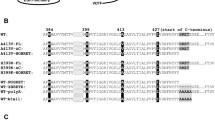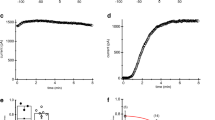Summary
We recently described a large, multiple-conductance Cl− channel in excised patches from normal T lymphocytes. The properties of this channel in excised patches are similar to maxiCl− channels found in a number of cell types. The voltage dependence in excised patches permitted opening only at nonphysiological voltages, and channel activity was rarely seen in cell-attached patches. In the present study, we show that Cl− channels can be activated in intact cells at physiological temperatures and voltages and that channel properties change after patch excision.
Maxi-Cl− channels were reversibly activated in 69% of cellattached patches when the temperature was above 32°C, whereas fewer than 2% of patches showed activity at room temperature. Upon excision, the same patches displayed large, multiple-conductance Cl− channels with characteristics like those we previously reported for excised patches. After patch excision, warm temperatures were not essential to allow channel activity; 37% (114/308) of inside-out patches had active channels at room temperature. The voltage dependence of the channels was markedly different in cell-attached recordings compared with excised patches. In cell-attached patches, Cl− channels could be open at cell resting potentials in the normal range. Channel activation was not related to changes in intracellular Ca2+ since neither ionomycin nor mitogens activated the channels in cell-attached patches, Ca2+ did not rise in response to warming and the Cl− channel was independent of Ca2+ in inside-out patches. Singlechannel currents were blocked by internal or external Zn2+ (100–200 μm), 4-acetamido-4′ isothiocyanostilbene-2,2′-disulfonate (SITS, 100–500 μm) and 4,4′-diisothiocyanostilbene 2,2′disulfonate (DIDS, 100 μm). NPPB (5-nitro-2-(3-phenylpropylamino)-benzoate) reversibly blocked the channels in inside-out patches.
Similar content being viewed by others
References
Bosma, M.M. 1989. Anion channels with multiple conductance levels in a mouse B lymphocyte cell line. J. Physiol. 410:67–90
Cahalan, M.D., Chandy, K.G., DeCoursey, T.E., Gupta, S. 1985. A voltage-gated potassium channel in human T lymphocytes. J. Physiol. 358:197–237
Cahalan, M.D., Lewis, R.S. 1988. Role of potassium and chloride channels in volume regulation by T lymphocytes. In: Cell Physiology of Blood. R.B. Gunn and J.C. Parker, editors, pp. 282–301. Rockefeller University Press, New York
Deutsch, C.J., Holian, A., Holian, S.K., Daniele, R.P., Wilson, D.F. 1979. Transmembrane electrical and pH gradients across human erythrocytes and human peripheral lymphocytes. J. Cell. Physiol. 99:79–94
Deutsch, C., Lee, S.C. 1988. Cell volume regulation in lymphocytes. Renal Physiol. Biochem. 3–5:260–276
Deutsch, C., Lee, S.C. 1989. Modulation of K+ currents in human lymphocytes by pH. J. Physiol. 413:399–413
Falke, L.C., Misler, S. 1989. Activity of ion channels during volume regulation by clonal N1E115 neuroblastoma cells. Proc. Natl. Acad. Sci. USA 86:3919–3923
Felber, S.M., Brand, M.D. 1982. Factors determining the plasma membrane potential of lymphocytes. Biochem. J. 204:577–585
Fernandez, J.M., Fox, A.P., Krasne, S. 1984. Membrane patches and whole-cell membranes: A comparison of electrical properties in rat clonal pituitary (GH3) cells. J. Physiol. 356:565–585
Geletyuk, V.I., Kazachenko, V.N. 1985. Single Cl− channels in molluscan neurones: Multiplicity of the conductance states. J. Membrane Biol. 86:9–15
Gogelein, M. 1988. Chloride channels in epithelia. Biochim. Biophys. Acta 947:521–547
Gray, L.S., Russell, J.H. 1986. Cytolytic T lymphocyte effector function requires plasma membrane chloride flux. J. Immunol. 136:3032–3037
Grinstein, S., Dixon, S.J. 1989. Ion transport, membrane potential, and cytoplasmic pH in lymphocytes: Changes during activation. Physiol. Rev. 69:417–481
Kao, J.P.Y., Harootunian, A.T., Tsien, R.Y. 1989. Photochemically generated cytosolic calcium pulses and their detection by fluo-3. J. Biol. Chem. 264:8179–8184
Kolb, H.A., Brown, C.D.A., Murer, H. 1985. Identification of a voltage-dependent anion channel in the apical membrane of a Cl−-secretory epithelium (MDCK). Pfluegers Arch. 403:262–265
Mahaut-Smith, M.P., Schlichter, L.C. 1989. Ca2+-activated K+ channels in human B lymphocytes and rat thymocytes. J. Physiol. 415:69–83
McCann, F.V., McCarthy, D.C., Keller, T.M., Noelle, R.J. 1989. Characterization of a large conductance non-selective anion channel in B lymphocytes. Cell. Signal. 1:31–44
Nelson, D.J., Tang, J.M., Palmer, L.G. 1984. Single-channel recordings of apical membrane chloride conductance in A6 epithelial cells. J. Membrane Biol. 80:81–89
Pahapill, P.A., Schlichter, L.C. 1990. Modulation of potassium channels in human T lymphocytes: Effects of temperature. J. Physiol. 422:103–126
Pahapill, P.A., Schlichter, L.C. 1991. Modulation of K+ channels in intact human T lymphocytes. J. Physiol. (in press)
Rosoff, P.M., Hall, C., Gramates, L.S., Terlecky, S.R. 1988. 4,4′ diisothiocyanostilbene-2,2′-disulfonic acid inhibits CD3-T cell antigen receptor-stimulated Ca2+ influx in human T lymphocytes. J. Biol. Chem. 263:19535–19540
Schlichter, L.C., Grygorczyk, R., Pahapill, P.A., Grygorczyk, C. 1990. A large multiple-conductance Cl channel in normal human T lymphocytes. Pfluegers Arch. 416:413–421
Schlichter, L.C., MacCoubrey, I.C. 1989. Interactive effects of Na and K in killing by human natural killer cells. Exp. Cell Res. 184:99–108
Vandenberghe, P.A., Ceuppens, J.L. 1990. Flowcytometric measurement of cytoplasmic free calcium in human peripheral blood T lymphocytes with fluo-3, a new fluorescent calcium indicator. J. Immunol. Methods 127:197–205
Welsh, M.J., Li, M., McCann, J.D. 1989. Activation of normal and cystic fibrosis Cl− channels by voltage, temperature and trypsin. J. Clin. Invest. 84:2002–2007
Wilson, H.A., Chused, T.M. 1985. Lymphocyte membrane potential and Ca2+-sensitive potassium channels described by oxonol dye fluorescence measurements. J. Cell. Physiol. 125:72–81
Woll, K.H., Leibowitz, M.D., Neumcke, B., Hille, B. 1987. A high-conductance anion channel in adult amphibian skeletal muscle. Pfluegers Arch. 410:632–640
Yamamoto, D., Suzuki, N. 1987. Blockage of chloride channels by HEPES buffer. Proc. R. Soc. London B. 230:93–100
Author information
Authors and Affiliations
Additional information
We thank E. Marcus for the fluo-3 measurements and for superb technical assistance. Dr. P. Pennefather for comments on the manuscript, and Dr. G. Downey and C.K. Chan for often providing T cells. This work was supported by a Medical Research Council (MRC) studentship to P.A.P. and grants from the MRC and the National Cancer Institute of Canada to L.C.S. L.C.S. is a Scholar of the MRC.
Rights and permissions
About this article
Cite this article
Pahapill, P.A., Schlichter, L.C. Cl− channels in intact human T lymphocytes. J. Membarin Biol. 125, 171–83 (1992). https://doi.org/10.1007/BF00233356
Received:
Revised:
Issue Date:
DOI: https://doi.org/10.1007/BF00233356




